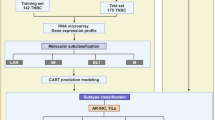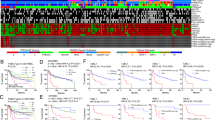Abstract
The molecular subtyping of triple-negative breast cancer (TNBC) is critical to guiding individualized patient treatment. In this study, we sought to characterize the clinicopathologic features of TNBC subtypes and to identify correlates of patient survival in an effort to provide a robust foundation for treatment planning. We additionally assessed PD-L1 expression in Chinese TNBC patients and evaluated the relationship between such expression and immunotherapeutic treatment outcomes. Based on analyses of histologic characteristics including apocrine differentiation, tumor-infiltrating lymphocytes, and metaplastic features, we selected immunohistochemical (IHC) markers including CD8, FOXC1, and AR for use in classifying TNBC cases. Associations between these subtypes and a range of clinicopathologic characteristics were evaluated. We classified a cohort of 93 TNBC patients into individuals with luminal androgen receptor (LAR), immunomodulatory (IM), basal-like immune-suppressed (BLIS), and mesenchymal (MES) tumor subtypes (23, 24, 39, and 7 cases, respectively). PD-L1 positivity was observed in 49.6% of cases and was more common in individuals with IM subtype disease. Mismatch repair deficiency (dMMR) was observed in just one patient. Significant differences in histologic grade, pT stage, lymphocyte distribution patterns, large scarring areas without cells in tumor of central (central scar), and PD-L1, P53, and Rb status were observed among these TNBC subtypes, whereas no such differences were observed with respect to age, invasion pattern, or pN stage. Rates of disease progression were higher at the 40–50 month follow-up time point, but there were no significant differences in recurrence-free survival or breast cancer-specific survival among these subtypes. IHC markers associated with clinicopathologic characteristics represent a powerful approach to TNBC molecular typing, providing a foundation for precision patient treatment. PD-L1 expression may represent a relevant factor in TNBC patient immunotherapeutic treatment planning, whereas dMMR is not likely to be of substantial value when evaluating immunotherapeutic efficacy in these patients.




Similar content being viewed by others
References
Chen W et al (2016) Cancer statistics in China, 2015. CA Cancer J Clin 66(2):115–132
Perou CM, Sorlie T, Eisen MB, van de Rijn M, Jeffreyk SS, Rees CA, Pollack JR, Ross DT, Johnsen H, Akslen LA, FlugeI O, Pergamenschikov A, Williams C, Zhu SX, Lùnning PE, Bùrresen-Dale A-L, Brown PO, Botstein D (2000) Comprehensive molecular portraits of human breast tumours. Nature 406:747–752
Siegel RL et al (2021) Cancer Statistics, 2021. CA Cancer J Clin 71(1):7–33
Rakha EA, Ellis IO (2009) Triple-negative/basal-like breast cancer: review. Pathology 41(1):40–47
Zhao S et al (2020) Molecular Subtyping of Triple-Negative Breast Cancers by Immunohistochemistry: Molecular Basis and Clinical Relevance. Oncologist 25(10):e1481–e1491
Cserni G et al (2021) Triple-negative breast cancer histological subtypes with a favourable prognosis. Cancers (Basel) 13(22):5694
Lehmann BD et al (2011) Identification of human triple-negative breast cancer subtypes and preclinical models for selection of targeted therapies. J Clin Invest 121(7):2750–2767
Burstein MD et al (2015) Comprehensive genomic analysis identifies novel subtypes and targets of triple-negative breast cancer. Clin Cancer Res 21(7):1688–1698
Jiang YZ et al (2019) Genomic and Transcriptomic Landscape of Triple-Negative Breast Cancers: Subtypes and Treatment Strategies. Cancer Cell 35(3):428-440 e5
Board WCoTE (2019) WHO classification of breast tumours. 5th edn, pp 82–109
Arciero CA et al (2020) Triple-negative apocrine carcinoma: A rare pathologic subtype with a better prognosis than other triple-negative breast cancers. J Surg Oncol 122(6):1232–1239
D’Arcy C, Quinn CM (2019) Apocrine lesions of the breast: part 2 of a two-part review. Invasive apocrine carcinoma, the molecular apocrine signature and utility of immunohistochemistry in the diagnosis of apocrine lesions of the breast. Journal of Clinical Pathology 72(1):7–11
Mao Y et al (2014) The value of tumor infiltrating lymphocytes (TILs) for predicting response to neoadjuvant chemotherapy in breast cancer: a systematic review and meta-analysis. PLoS ONE 9(12):e115103
Mao Y et al (2016) The Prognostic Value of Tumor-Infiltrating Lymphocytes in Breast Cancer: A Systematic Review and Meta-Analysis. PLoS ONE 11(4):e0152500
Shuzhen Liu JL (2012) Samuel Leung, Dongxia Gao, William D Foulkes, Torsten O Nielsen, CD8 + lymphocyte infiltration is an independent favorable prognostic indicator in basal-like breast cancer. Breast Cancer Res Treat 14:R48
Salgado R et al (2015) The evaluation of tumor-infiltrating lymphocytes (TILs) in breast cancer: recommendations by an International TILs Working Group 2014. Ann Oncol 26(2):259–271
Vijay GV et al (2019) GSK3beta regulates epithelial-mesenchymal transition and cancer stem cell properties in triple-negative breast cancer. Breast Cancer Res 21(1):37
Das V et al (2019) The basics of epithelial-mesenchymal transition (EMT): a study from a structure, dynamics, and functional perspective. J Cell Physiol 234:14535–14555
Hammond ME et al (2010) American Society of Clinical Oncology/College Of American Pathologists guideline recommendations for immunohistochemical testing of estrogen and progesterone receptors in breast cancer. J Clin Oncol 28(16):2784–2795
Wolff AC, Hammond M, Allison KH et al (2018) Human epidermal growth factor receptor 2 testing in breast cancer American Society of Clinical Oncology/College of American Pathologists clinical practice guideline focused update. J Clin Oncol 20:210–212
Alsner J, Jesnsen V, Kyndi M, Offersen BV, Vu P, Borresen-Dale AL, Overgaard J (2008) A comparison between p53 accumulation determined by immunohistochemistry and TP53 mutations as prognostic variables in tumours from breast cancer patients. Acta Oncol 47(4):600–607
Schmid P et al (2018) Atezolizumab and Nab-Paclitaxel in Advanced Triple-Negative Breast Cancer. N Engl J Med 379(22):2108–2121
Chen DS, Mellman I (2017) Elements of cancer immunity and the cancer-immune set point. Nature 541(7637):321–330
Farmer P et al (2005) Identification of molecular apocrine breast tumours by microarray analysis. Oncogene 24(29):4660–4671
Gerratana L et al (2018) Androgen receptor in triple negative breast cancer: A potential target for the targetless subtype. Cancer Treat Rev 68:102–110
Traina TA, Miller K, Yardley DA, Eakle J, Schwartzberg LS, O’shaughnessy J, Gradishar W, Schmid P, Winer E, Kelly C, Nanda R, Gucalp A, Awada A, Garcia-Estevez L, Trudeau ME, Steinberg J, Uppal H, Tudor IC, Peterson A, Cortes J (2018) Enzalutamide for the treatment of androgen receptor-expressing triple-negative breast cancer. J Clin Oncol 36:884–890
Zuo WJ et al (2016) Dual Characteristics of Novel HER2 Kinase Domain Mutations in Response to HER2-Targeted Therapies in Human Breast Cancer. Clin Cancer Res 22(19):4859–4869
Castaneda CA et al (2016) Tumor infiltrating lymphocytes in triple negative breast cancer receiving neoadjuvant chemotherapy. World J Clin Oncol 7(5):387–394
Carter JM et al (2021) Characteristics and Spatially Defined Immune (micro)landscapes of Early-stage PD-L1-positive Triple-negative Breast Cancer. Clin Cancer Res 27(20):5628–5637
Ahn SG et al (2021) Clinical and genomic assessment of PD-L1 SP142 expression in triple-negative breast cancer. Breast Cancer Res Treat 188(1):165–178
Mills AM, Dill EA, Moskaluk CA, Dziegielewski J, Bullock TN, Dillon PM (2017) The relationship between mismatch repair deficiency and PD-L1 expression in breast carcinoma. Am J Surg Pathol 42(2):183–191
Ray PS et al (2010) FOXC1 is a potential prognostic biomarker with functional significance in basal-like breast cancer. Cancer Res 70(10):3870–3876
Lang GT et al (2017) The spectrum of BRCA mutations and characteristics of BRCA-associated breast cancers in China: Screening of 2,991 patients and 1,043 controls by next-generation sequencing. Int J Cancer 141(1):129–142
Subhawong AP, Subhawong T, Nassar H, Kouprina N, Begum S, Vang R, Westra WH, Argani P (2009) Most basal-like breast carcinomas demonstrate the same Rb-/p16+ immunophenotype as the HPV-related poorly differentiated squamous cell carcinomas which they resemble morphologically. Am J Surg Pathol 33:163–175
Jones RA et al (2016) RB1 deficiency in triple-negative breast cancer induces mitochondrial protein translation. J Clin Investig 126(10):3739–3757
Knudsen ES et al (2015) RB loss contributes to aggressive tumor phenotypes in MYC-driven triple negative breast cancer. Cell Cycle 14(1):109–122
Li Y et al (2015) Suppression of cancer relapse and metastasis by inhibiting cancer stemness. Proc Natl Acad Sci U S A 112(6):1839–1844
Sonnenblick A et al (2015) Constitutive phosphorylated STAT3-associated gene signature is predictive for trastuzumab resistance in primary HER2-positive breast cancer. BMC Med 13:177
Reddy TP et al (2020) A comprehensive overview of metaplastic breast cancer: clinical features and molecular aberrations. Breast Cancer Res 22(1):121
Funding
This study was supported by grants from the Shanxi Provincial Health Commission (2020065) and the Institute Research Foundation of Shanxi Cancer Hospital (0200189).
Author information
Authors and Affiliations
Contributions
Jing Lian, Ke-MingYun, and Yan-Feng Xi identified cases of interest and designed the study. Jing Lian and Peng Bu carried out the studies. Jing Lian and Hai-Xia Ma collected data and performed the statistical analysis. Jing Lian and Li-Xia Wang produced the initial draft of the manuscript. Jing Lian, Ke-Ming Yun, and Yan-Feng Xi contributed to the revision of the manuscript. All authors participated in writing, editing, and reviewing the manuscript and gave final approval for publication. Jing Lian takes responsibility for the integrity of the data and the accuracy of the data analysis.
Corresponding authors
Ethics declarations
Ethics approval
Material and patient date used in this study were provided by the Shanxi Cancer Hospital. The study was approved by the institutional review board of the ethical committee at the Shanxi Cancer Hospital, according to the Declaration of Helsinki (Approval Number: 2019075).
Conflict of interests
All authors have declared that no conflict of interest exists.
Additional information
Publisher’s note
Springer Nature remains neutral with regard to jurisdictional claims in published maps and institutional affiliations.
Rights and permissions
About this article
Cite this article
Lian, J., Ma, Hx., Xu, EW. et al. Subclassifying triple-negative breast cancers and its potential clinical utility. Virchows Arch 481, 13–21 (2022). https://doi.org/10.1007/s00428-022-03329-0
Received:
Revised:
Accepted:
Published:
Issue Date:
DOI: https://doi.org/10.1007/s00428-022-03329-0




